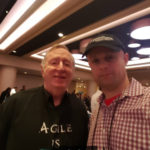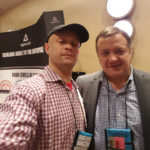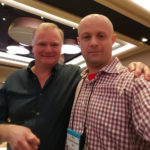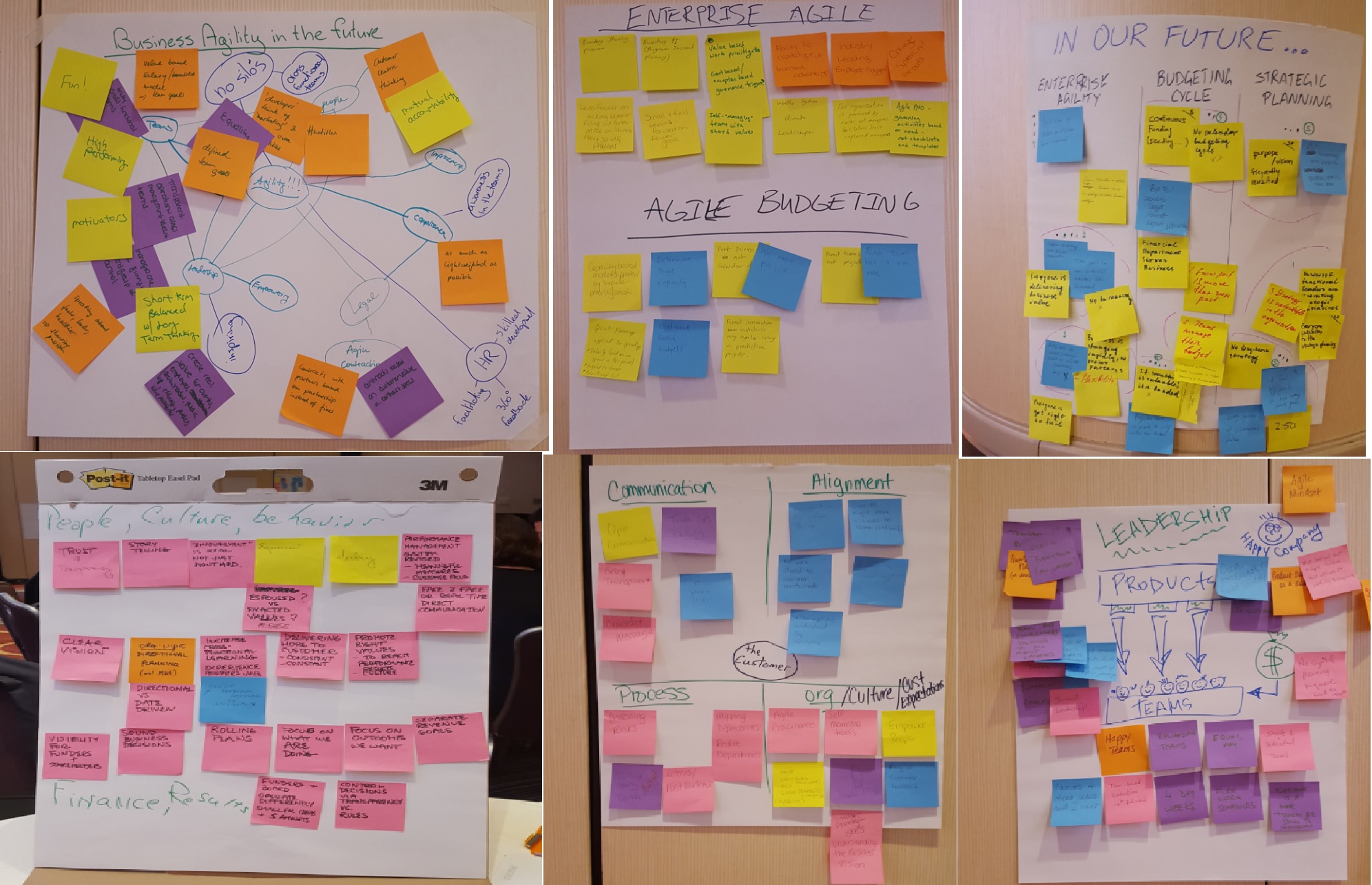On 23-24th of February, there was the first ever 2017 – Business Agility Conference, held in NYC. The event could be best described as “…2 days of authentic short stories and facilitated deep dives on business agility; focus on organizational design, market disruption and product innovation, agile outside IT and next-generation leadership…” (quoted from https://businessagility2017.com/)
The uniqueness of this event was due its demographics, and in particular: due to the breakdown of attendees – based on their organizational roles. Although agile conferences (both, local and global) are never geared towards Technology and Information Systems only, this particular event was specifically geared towards business. As it can be seen from the statistics below, there were a very large number of people that represented Senior and Executive Management (more than 45%).

As always, another large share of attendees was represented by organizational and agile coaches.
It is also interesting to know that there were practically no discussions at the event about Scrum, Kanban, XP, tools, processes or frameworks, at the event.
My personal, experience as one of the facilitators of this event, was enriched by reuniting with some folks, whose work had significant impact on my own work:
 With Steve Denning With Steve Denning |
 With Mike Beedle With Mike Beedle |
 With Bjarte Bogsnes With Bjarte Bogsnes |
Note: Special thanks to Mike Beedle for mentioning my name in his Enterprise Scrum Executive Summary. (download pdf report to view)
Highlights from Steve Denning’s Presentation:
According to Steve Denning – the author of Radical Management, 20th Century Teams – were “teams” in name-only. Team of the 20th century were gears of a classic, bureaucratic organizational machine, characterized by: top-down management, individual responsibilities and little interaction among people. On contrary, real Agile teams require: autonomy & cross-functional structure, collective accountability and high degree of interaction. Steve focused on the following four main Agile themes:
- Delighting Customer – there needs to be a fundamental shift in how management perceives relationships between Firm and Customer. This shift is best described by Copernican revolution: no longer Firm remains a centerpiece, with Customer revolving around it. Instead, Customer becomes a centerpiece and Firm revolves around Customer, delivering products, services and ensuring overall satisfaction. Pre- Copernican Management belief was in making the main purpose of a firm to generate money for its stakeholders and was best described by Jack Welch’s quote: “…The dumbest idea in the world…” The Post-Copernican Management belief is that, as was described by Peter Ducker in 1954: “…the only valid purpose of a firm is to create a customer…”
- Descaling Work – in a volatile and complex modern world, where uncertainty and ambiguity prevails, any attempts to resolve big problems simultaneously, with one big-bang approach, are no longer effective. Instead, work must be dis-aggregated in small batches and performed by small, autonomous, cross-functional teams.
- Enterprise-Wide Agility – to consider Agile as “IT thing only” is a huge mistake. Attempts to improve organizational agility, with only a few small teams trying to “do agile”, with the rest of the organization remaining top-down, bureaucratic, slow-moving behemoth will result in a failure. In order for the whole organization to become more agile, it has to embrace the entrepreneurial mindset front-to-back and top-to-bottom.
- Nurturing Culture – is a huge undertaking that each organization must commit to and flourish from within. This includes leadership strategies, organizational structure, culture, norms, values and principles. Excluding organizational design and system dynamics from agile transformation efforts by senior leaders is a costly mistake.
Throughout his presentation, Steve Denning highlighted additional important aspects of organizational agility:
- “How many layers should Organization have?” – There is no perfect number to give, but the fewer – the better. What matters is that there should be full transparency and direct communication between: Management, Customers/Users and Workers (employees, contractors, suppliers)
- The Law of Network – “plugging” agile team into a bureaucratic environment may create visibility of local efficiency but over time will lead to unbearable friction between “old” and “new”.
- There is a lot of “Agile PR” and “fake Agile” – it is usually brought about by IT attempts to embrace agility, with very limited support from business. Frequent claims from management (sometimes, very senior) that is indicative of their gross misunderstanding of organizational dynamics is:
- Agile is only for software
- Agile does not scale
- Agile cannot handle complexity
- Agile is not reliable
- Agile does not last
Steve Denning’s discussion was summarized by the example of Microsoft: “In 2004, Microsoft was viewed as a huge battleship, slowly moving through waters at relatively low speed, and not being able to turn quickly and cost-efficiently. In 2015, Microsoft is viewed as a flotilla of speedboats, moving fast but synchronously, and being able to turn “…on a dime for a dime…” (the author’s of this post quotes C. Larman)”
Highlights from Bjarte Bogsnes Presentation:
The chairman of Beyond Budgeting Roundtable (BBRT) Bjarte Bogsnes, who has a long international career in Finance and HR, with successful implementation of BB at two large European companies, Statoil and Borealis, presented a short synopsis on Adaptive Management Model.
(Note: Being Bjarte’s follower and advocate for years, I recommend for your attention the following personal summary page: for in-depth understanding of Bjarte’s work).
Bjarte made a clear distinction between Management and Leadership. People obey Managers (usually, mandatory) and follow Leaders (always, voluntarily). Management is focused on: Rhythms (around events), Targets, Plans and Forecasts, Resource Allocation, Performance Evaluation and Rewards Distribution. On contrary, Leadership is focused on: Purpose, Values, Transparency, Organization, Autonomy and Customers. A lot of focus in Bjarte’s discussion was paid to ineffectiveness of fixed (“accordion-like”) budgets that are driven by calendar years, not by business cycles; harm and dangers of producing and measuring wrong KPIs (often mistakenly considered as “KPTs”, where “T” stands for “truths”); lumping Budgets, Forecasts and Resources Allocation into one single KPI number, and then, coupling such ill-defined KPIs with individual appraisals and monetary rewards/bonuses – the main cause of system gaming and unethical behaviors that many organizations see today. Bjarte’s presentation was followed by comprehensive collaboration, by many individual teams that used a variety of visualization techniques to illustrate a future state of agile budgeting & finance:
Other Great Highlights:
There were a few other great discussions that took place at the conference. Here are a few excerpts that are worth including (paraphrased here):
- From Charlie Rudd: “…Organizational Change Management != Organizational Transformation. Many more people tend to resist to the former; much less so to the ladder…” and “…In Change Management, processes and system behaviors are predictable. In Transformations – they are not…”
- From Paul Cobban: “…Agile Education is not just for doers. It is also for Executive folks…Exempting themselves from continuous education, Executives lose touch with reality” and “…Stop Starting and Start Finishing…(or learn how to manage WIP at enterprise level)”
- From David Grabel: “…Agile is not just for IT. A great example of Agile adoption success is Marketing…” and “…Adoptive, agile Marketing can drive organizational agility at large…”
- From Venkateswaran NS: “…Do senior leaders have good vision? Does middle-management have right job descriptions (for themselves and their subordinates)?…”
- From Pat Reed: “…Business Agility – is bravery to step into the area of unknown…” and “…the phrase ”I will believe it when I see it”…should become “I will see it when I start believing it”
- From Fabiola Eyholzer: “…HR should stand for Human Relationships not Resources (from the author of this post: there is a common belief that calling humans as ‘resources’ is demotivating and disrespectful)…” and “…most discussions between employees and HR are scripted and lack sincerity and open-mindedness due to the fact that there is always a legal aspect to it and both parties are great of doing CYA…”
- From Chip Loving and Jason Hall: “…Management by Objectives is wasteful and harmful…” and “…Transparency != Awareness…(from the author of this post: being able to see something and fully comprehend it, is not the same thing)” and “…Quarter-based profit sharing that is peer-based and transparent is much better than end-of-year subjective discretionary bonus decided by people that are mostly remote from action and area, where real business value is produced…”
- From the author of this post: example of most harmful intensives allocation schema and less harmful intensives allocation schema
 Finally, some great new publications were presented at the event. I came to discover that my colleague and friend, agile coach Dana Pylayeva has published her new book “Introduction to DevOps with Chocolate, LEGO and Scrum Game”. It goes on my To-Do list to read.
Finally, some great new publications were presented at the event. I came to discover that my colleague and friend, agile coach Dana Pylayeva has published her new book “Introduction to DevOps with Chocolate, LEGO and Scrum Game”. It goes on my To-Do list to read.


Author’s note: folks,
Good
While we are still, just a half-way into the first week of training, I would like to give you heads-up on what I wish to focus on the last day (or two, depending on how we will be progressing through our learning objectives) of our training: a practical exercise that should give you a better idea what needs to be done during the initial (preparatory) phase of LeSS adoption.
Specifically, I would like to look into product definition/initial backlog creation/team ‘blue-print’ refining, building a hypo around what LeSS Product Group organizational design may look like. I would like to look into persona identification, customer journey mapping, use case decomposition, user story mapping and finally, product canvasing – some pretty useful techniques for creating a product backlog.
For this, I would like you to start thinking (and picking a good working example from your own daily routine) what a ‘product candidate’ may look like. Even if it is rogue/coarse-grained ‘product’, or something you suspect not being a product (but you have to treat it, as a product ;)), – lets start there.
After this week, you should have better understanding on what a real product is, anyway:).
Based on the above, we shall be revisiting some key content for LeSS learning, from the first few sessions.
It should all tie together.
Thanks,
Gene